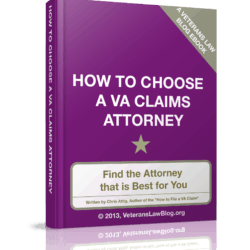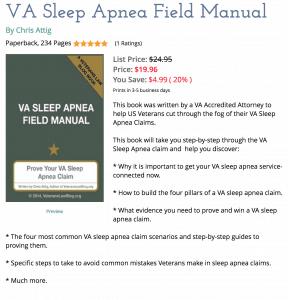This is part 2 in a 3 part series on maximizing your VA Rating for Migraine headaches. You can read more about how to get VA Disability for Migraine headaches by clicking here to read the first part of the series. And you can learn more about proving VA Disability compensation for headaches in Part 3 of this series by clicking here.
In this part I want to show you how headaches are translated into a monetary rating – or, more simply put, how to figure out and maximize the VA rating for migraine headaches.
As you will see below, there is one MAJOR key to maximizing your headache rating – and what it is should come as NO surprise to regular readers of the Veterans Law Blog.
Let’s jump right in…..
1) How do you figure out the right VA Rating for Migraine Headaches?
Once a condition is service-connected, the VA’s next step is to “rate” the condition. This essentially means translating your symptoms and limitations from your condition into a percentage, which then equates to a monthly dollar amount.
When it comes to the VA rating for migraine headaches, the VA uses Diagnostic Code 8100 (38 C.F.R. § 4.124a, Diagnostic Code 8100) which is found in the Impairment Ratings Tables. You can see the summary below:
10% – Evidence of Characteristic Prostrating Attacks Due to Migraines that average 1 every 2 months, lasting over several months.
30% – Characteristic prostrating attacks occurring on an average of once a month over the last several months.
50% – Very frequent completely prostrating and prolonged attacks productive of severe economic inadaptability.
A couple points to note.
The highest SCHEDULAR VA rating for migraine headaches is 50%. But that does NOT mean – as some will tell you – that this is the highest rating you can get for the condition. If your symptoms and limitations from your headaches are different from those listed above, you are entitled by law to an extra-schedular rating.
Extra-schedular ratings are tough to prove and win – and extremely difficult to convince the VA to consider. Most raters have never heard of the extra-schedular rating; fewer still know how to apply it. You can read more about extra-schedular ratings – explained in the context of getting a higher hearing loss rating – by clicking here.
Another point note is this: how many of the above symptoms in the above table listing the VA rating for migraine headaches are exclusively observable by a medical doctor?
None. Nada. Zip. Zilch. Zero, Nein. A big goose egg.
After getting medical evidence of a diagnosis for your headaches, and using medical evidence to prove nexus to military service, every single factor for theVA rating for migraine headaches is capable of observation by the Veteran experiencing the symptoms or by someone that observes the symptoms in the Veteran.
At this point, whistles and bells should be sounding – and you should be thinking “Lay Evidence”. When it comes to proving the highest possibleVA rating for migraine headaches, Lay Evidence is vital.
Your lay evidence should focus on the 3 major criteria for rating a condition: the Frequency, Chronicity and Severity of the symptoms and limitations.
Your lay evidence should come from more than just you, the Veteran. Family members, colleagues, golf buddies, hunting or fishing buddies – anybody that has witnessed the frequency, chronicity and severity of your migraine or headache symptomatology should be called on to provide lay evidence to support your headache rating proof.
Bottom line – if you are under-rated for your headaches in a VA claim, I would be willing to bet a box full of hundred dollar bills it is because you did not submit enough 5-Star Lay Evidence to support a higherVA rating for migraine headaches.
I discuss Lay Evidence – its power, how to develop it, and how to submit it properly – in the VA Claims Evidence Field Manual.
You can purchase a copy of the eBook here, or save some money and buy it as part of the VA Sleep Apnea training package.
2) What are the Key Terms in the Criteria for a VA Rating for Migraine Headaches….and what do they Really Mean?
Notice in the above listed criteria that almost all of theVA rating for migraine headaches turn on 2 concepts: the severity and frequency of the prostrating attacks, and this concept of “economic in-adaptability”.
Unfortunately, these terms are very vague, and have not been well-defined in VA case law. This means that the VA can interpret them as they see fit.
With that in mind, let’s talk a little about what they actually should mean.
As mentioned above, the criteria the VA uses for rating migraine headaches in VA Regulations and rating manuals do not define what it means to have a “prostrating” attack. Nor has the Veterans Court.
Take a look at the case of Fenderson v. West, 12 Vet. App. 119 (1999), as an example. In that case, the Court quoted Diagnostic Code 8100 verbatim, but failed to specifically address the matter of what is a prostrating attack for the purposes of a VA rating for migraine headaches.
In more than a few BVA decisions, though, there is some information which is helpful. For example, the BVA notes that according to Webster’s II New College Dictionary Of American English, Third College Edition, 889, (c) 2001, “prostration” is defined as “physically or emotionally exhausted; incapacitated.”
A very similar definition is found in Dorland’s Illustrated Medical Dictionary, 32nd Ed., 1531, (c) 2012, in which “prostration” is defined as “extreme exhaustion or powerlessness.” Dorland’s is not frequently quoted or referenced in BVA decisions, but it is a credible and competent source for demonstrating the meaning of medical terms that aren’t defined by the VA or in Veterans case law.
What is the point of all this?
When you are building your lay evidence to show the frequency, severity and chronicity of your headaches for VA Claim rating purposes, you are going to want to include these definitions – AND speak of the symptoms you experience in the language of “extreme exhaustion”, “powerlessness”.
As someone that has presumably experience a debilitating headache, I am sure that you know exactly how exhausting and powerless you feel to have to lay in bed, in the dark, bracing the floor to keep from vomiting.
After all, these aren’t the “oops-I-had-too-many-shots-of-Jaeger” headaches.
The types of headaches Veterans experience from TBIs, sleep apnea, migraines, and more, are the kind that put you “down for the count”…sometimes for days instead of just hours.
Let’s take a look at the second vague term that is key to understanding how to secure a proper VA rating for migraine headaches: severe economic inadaptability.
The VA has long interpreted this term as meaning “unemployability“, confusing it with a TDIU unemployability claim. But the VA has been told, time and again that it is wrong to interpret it this way.
For example, a 2004 Veterans Court case gave us some insight into what this term means, but stopped just short of an actual useable definition.
In that case, the Court said that when speaking of economic inadaptability, nothing in DC 8100 requires the Veteran be completely unable to work in order to qualify for a fifty percent evaluation. Pierce v. Principi, 18 Vet.App. 440, 446 (2004). The Court went on to say that “If ‘economic inadaptability’ were read to import unemployability, the appellant, if he met the economic-inadaptability criterion, would then be eligible for a rating of [TDIU] rather than just a [fifty percent evaluation.” Id.
In short, the Court told us 2 important pieces of information: severe economic inadaptability is NOT unemployability, and in fact, it is something considerably less. The Court highlighted this point in a single-judge, non-precedential, decision in July 2016, when the Veterans Court Judge wrote: “Nothing in the rating schedule [for headaches] requires unemployability to find that a 50% rating is warranted.” Acosta v. McDonald, CAVC 15-1560 (July 28, 2016).
So, when trying to prove that you have “severe economic inadaptability” for the purposes of a 50% VA rating for migraine headaches, you will again want to focus on 5-Star Lay Evidence. That lay evidence should turn on some of the following factors:
- Income that doesn’t meet your expenses, despite your best efforts, because of your headaches
- Job losses, or workplace accommodations that have limited your income, because of your headaches or the prostrating attacks.
- Inability to perform the job duties you are assigned or trained for, or focus on work tasks, due to the headaches or the prostrating attacks
- Difficulty applying or interviewing for work because of headaches or the prostrating attacks
- Prolonged difficulty with any phase of income production , that limits your earning potential, or that makes you less competitive than you otherwise should be with your background, skills, education and training: application for work, creation of a business, inability to do the work, focus on the tasks of work, managing your money (be careful with this one, though, for the reasons in this post).
In short, the concept of “severe economic inadaptability is very broad, and limited only by our inability to paint a picture for the VA examiner, rater or BVA judge.
Next up in this 3-part series: in part 3 of this series, I will give you some practical tips and pointers for fully developing and proving entitlement so you can get the most VA disability compensation for headaches.






